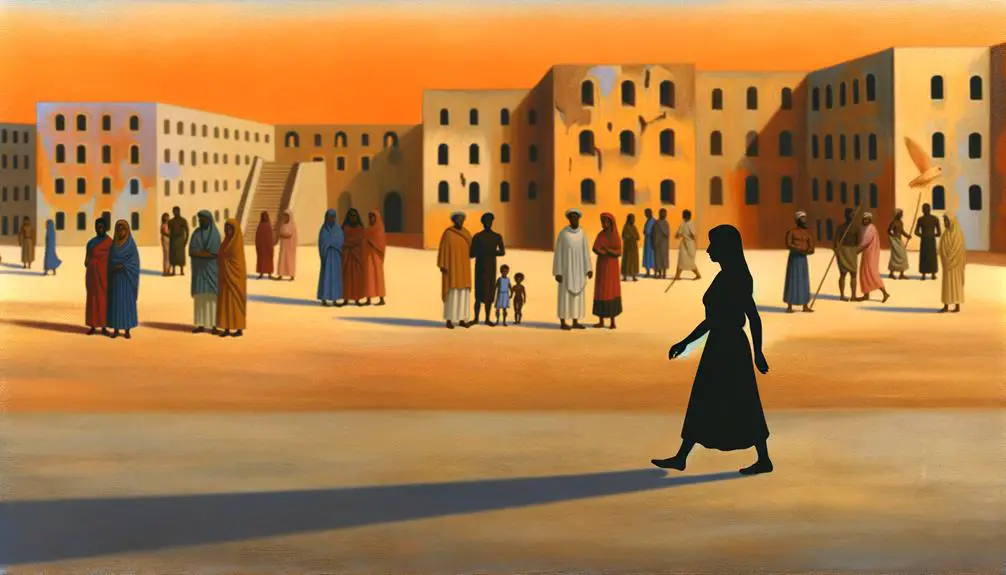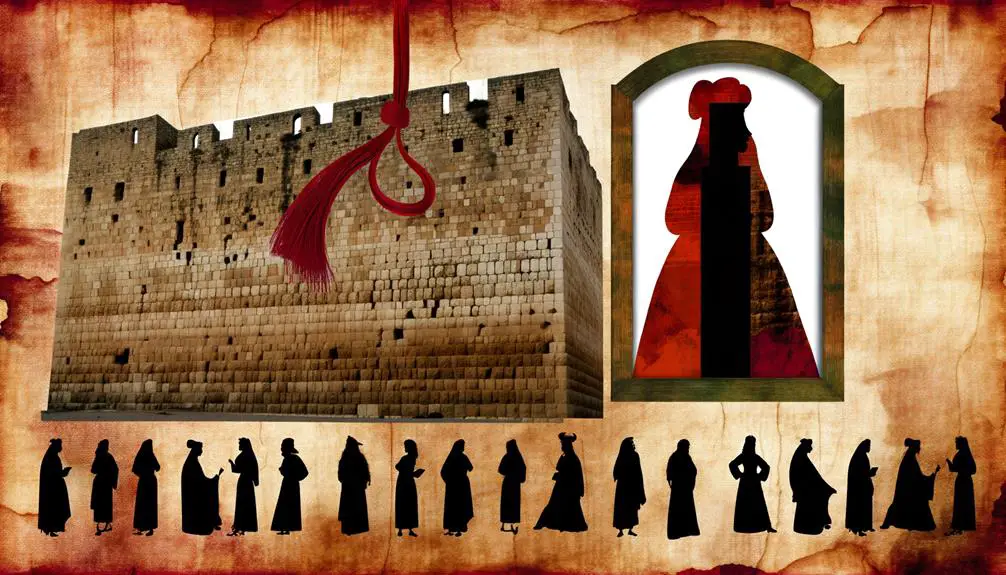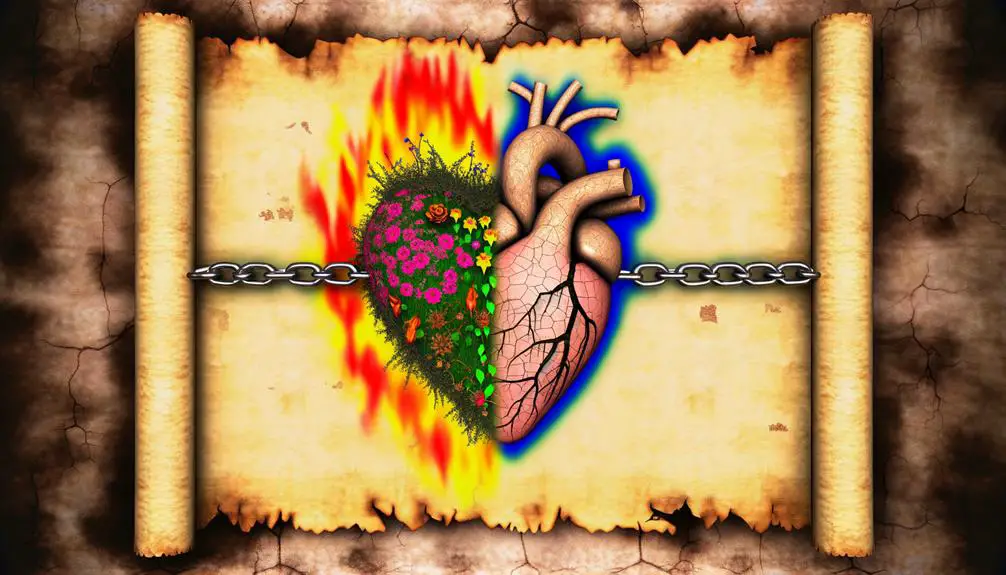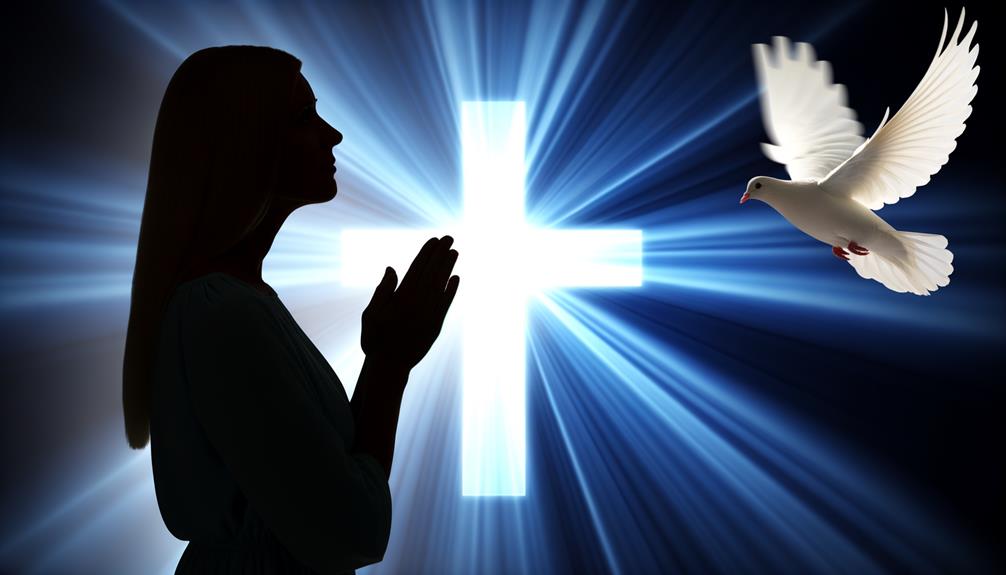Yield to the intriguing exploration of 'harlot' in the Bible, where morality, redemption, and divine teachings converge in unexpected ways.

Meaning of Harlot in the Bible
In the sacred texts, the term 'harlot' juxtaposes moral frailty against the backdrop of divine commandments, inviting you to explore a complex narrative.
You'll find that 'harlotry' isn't just about sexual immorality; it's interwoven with themes of idolatry, betrayal, and ultimately, redemption.
As you navigate through the historical context, symbolism, and notable figures associated with this term, consider how these stories reflect broader spiritual and moral lessons.
This journey promises to challenge your understanding of biblical teachings and their relevance in contemporary discussions on morality and forgiveness.
Why does this matter?
The answer lies in the nuanced interpretation of these ancient texts and their profound impact on modern beliefs.
Key Takeaways
- 'Harlot' in the Bible extends beyond sexual immorality to symbolize spiritual betrayal and moral debates.
- Notable figures like Rahab and Mary Magdalene highlight mislabeling and the potential for redemption.
- The term encompasses warnings against pagan practices and stresses the importance of personal and communal fidelity.
- Modern interpretations, including feminist perspectives, challenge traditional views and emphasize the complexity of women's roles in biblical narratives.
Historical Context of 'Harlot

In exploring the historical context of 'harlot' within biblical texts, it's essential to recognize that this term encapsulates more than its modern connotations suggest, serving as a multifaceted symbol in ancient narratives. The role of a 'harlot' in the Bible can't be examined without considering the societal roles and ancient professions that shaped the social fabric of the times.
As you delve deeper, you'll find that the term 'harlot' wasn't exclusively tied to sexual immorality but was often used in a broader sense. It encompassed various societal roles that women and, occasionally, men assumed outside the conventional family structure. These roles were pivotal in ancient economies and social systems, where survival often depended on the collective contributions of every member.
Analyzing biblical references, it becomes apparent that 'harlots' were sometimes integrated into the social and religious fabric of their communities. Their presence and professions were a reflection of the complex social hierarchies and economic necessities of ancient civilizations. The term, therefore, can serve as a window into understanding the dynamics of power, gender, and economy in biblical times.
Moreover, the portrayal of 'harlots' in biblical narratives can provide insight into the values, fears, and aspirations of ancient societies. Through the lens of these stories, you're able to glimpse the multifaceted nature of human societies, where the label of 'harlot' mightn't simply denote a profession but symbolize non-conformity to established societal roles.
Harlotry and Sexual Immorality

Harlotry, often linked with sexual immorality in biblical texts, serves as a complex symbol of disobedience and moral decay within ancient societies. This association isn't merely literal but extends into broader moral debates and interpretation of prostitution laws as they were understood and applied in historical contexts. You'll notice that the biblical narrative doesn't shy away from addressing harlotry, rather, it delves into the subject to offer lessons on morality and societal values.
The discussions surrounding harlotry in the Bible often intersect with the legal and ethical considerations of the time. Prostitution laws, as inferred from biblical passages, weren't just regulatory but also reflective of the era's understanding of morality and purity. These laws weren't uniform but varied, indicating a complex relationship between societal norms and sexual practices.
Furthermore, the moral debates encapsulated in these texts highlight a tension between individual actions and societal expectations. Harlotry, in this context, isn't only about the act itself but also about the defiance of divine and societal laws. It's a manifestation of a broader theme of rebellion against established norms and a deviation from the path of righteousness as defined by the religious and cultural standards of the time.
Analyzing harlotry and sexual immorality through biblical narratives provides insight into how ancient societies navigated the complexities of human behavior, law, and morality. It underscores the importance of understanding historical and cultural contexts to grasp the full meaning and implications of these concepts within the biblical framework.
Symbolism of Idolatry

Symbolism of idolatry throughout the Bible often serves as a metaphor for the betrayal of divine trust, reflecting a profound message about faithfulness and spiritual fidelity. When you delve into the biblical narrative, you encounter numerous instances where idolatry isn't merely the act of worshipping false gods, but it symbolizes a deeper estrangement from the covenant with the divine. This betrayal is likened to the unfaithfulness of a harlot, underscoring the gravity of turning away from divine mandates towards pagan rituals and worship practices.
Idolatry, within this context, isn't confined to the physical act of bowing before idols. It encompasses a broad spectrum of behaviors that place anything—be it wealth, power, or pagan deities—at the center of one's life, thereby relegating the divine to a secondary status. This reorientation towards pagan rituals and worship practices illustrates a profound departure from the spiritual fidelity expected by the divine. The Bible uses this imagery to caution against the seductive allure of such practices, which are often depicted as harlotry to emphasize their betrayal and the ensuing spiritual adultery.
This symbolic use of idolatry serves as a critical lens through which to understand the broader theological themes of the Bible. It challenges you to reflect on the nature of your own fidelity—be it spiritual, moral, or relational. The invocation of idolatry as spiritual harlotry thus becomes a powerful allegory, urging a return to a path of faithfulness and reminding you of the perils of spiritual adultery through the pursuit of pagan rituals and worship practices.
Notable Biblical Harlots

In exploring the notable harlots of the Bible, you'll encounter figures such as Rahab of Jericho, whose story intertwines with the conquest of Canaan.
There's also a common misconception regarding Mary Magdalene, often mistakenly labeled as a harlot despite biblical texts not supporting this claim.
These examples serve as critical points for understanding the varied roles and representations of harlots within biblical narratives.
Rahab of Jericho
Among the notable harlots in the Bible, Rahab of Jericho stands out for her critical role in the story of the Israelite conquest of Jericho. Her actions, particularly in sheltering Israelite spies, mark a pivotal moment in biblical history.
Analyzing Rahab's story offers insight into:
- Rahab's Lineage: Rahab's inclusion in the genealogy of Jesus highlights her significance beyond her initial role.
- Spy Sheltering: Her decision to hide the spies underlines her strategic importance and bravery.
- Faith and Redemption: Rahab's story is often cited as an example of faith leading to redemption.
- Cultural Impact: Her narrative has influenced how women's roles are perceived within biblical contexts.
Rahab's transformation from a harlot to a key figure in biblical history underscores the complexity of her character and her enduring legacy.
Mary Magdalene Misconception
One common misconception about Mary Magdalene is her wrongful identification as a harlot within biblical narratives, a label that lacks scriptural basis and distorts her true significance. This Apostolic misrepresentation has shadowed her true role and contributions.
Analyzing the texts, you'll find no direct evidence supporting this claim; instead, her depiction as a devoted follower of Jesus, who played a pivotal role in Magdalene's ministry, emerges. This mislabeling not only undermines her importance but also reflects broader issues of gender bias within historical and religious interpretation.
It's crucial to challenge and correct these misconceptions, recognizing Mary Magdalene's rightful place as a key figure in early Christianity, untainted by unfounded accusations of immorality.
Harlotry as Spiritual Betrayal

Several biblical passages depict harlotry not merely as a moral failing but as an emblematic act of spiritual betrayal against God. This perspective underscores the depth of the relationship between the divine and humanity, framing it in terms of loyalty and faithfulness akin to a covenant between spouses. In this light, harlotry transcends physical adultery to represent a profound disloyalty to God's commandments and love.
This act of spiritual betrayal is highlighted through:
- Divine warnings: Scriptures are replete with admonitions against turning away from God to pursue other deities or engage in practices contrary to divine law. These warnings aren't merely guidelines but serve as a testament to the gravity of covenant breaches.
- Covenant breaches: When the Israelites veered towards idolatry or adopted customs of neighboring pagan cultures, prophets likened these actions to harlotry. Such breaches signified a turning away from a unique and sacred bond established by God with His people.
- Prophetic metaphors: Prophets like Hosea employed the metaphor of harlotry to vividly illustrate Israel's unfaithfulness. In his narrative, Hosea's own marriage to a harlot becomes a powerful symbol of God's enduring love for a wayward Israel.
- Spiritual ramifications: The biblical narrative positions spiritual harlotry as an act with severe consequences, not only affecting the individual's relationship with God but also impacting the communal integrity and divine protection over the nation.
In analyzing harlotry as spiritual betrayal, the biblical text urges a reflection on the sanctity of the divine-human covenant, emphasizing the seriousness of fidelity and the dangers of forsaking divine commandments.
Redemption Narratives

While the Bible starkly portrays the gravity of spiritual harlotry, it equally offers narratives of redemption, highlighting God's willingness to forgive and restore those who turn back to Him. These stories serve not just as moral lessons but as profound grace narratives, illuminating the depths of God's merciful character and His desire for reconciliation.
At the heart of these redemption narratives is a complex interplay of divine grace and human response, a dynamic central to understanding redemption psychology. This psychology isn't merely about guilt and forgiveness but encompasses a transformative journey from estrangement to reconciliation, from shame to dignity.
Here's a glance at how the Bible weaves these themes:
Character |
Narrative |
Significance |
|---|---|---|
Rahab |
A harlot who aids Israelite spies, later integrating into the Israelite community. |
Demonstrates transformative grace, showing that one's past does not define their future in God's eyes. |
Gomer |
Prophet Hosea's wife, whose unfaithfulness symbolizes Israel's betrayal of God. |
Highlights God's relentless pursuit and willingness to restore, despite repeated betrayal. |
Mary Magdalene |
Early follower of Jesus, often misinterpreted as a harlot, who finds redemption. |
Illustrates personal transformation and the power of direct encounter with divine grace. |
These stories underscore that redemption is accessible to all, regardless of past transgressions. They're not just ancient tales but resonate with timeless truths about human frailty and divine forgiveness, embodying the essence of redemption psychology and grace narratives. Through these narratives, the Bible assures you that redemption is not just a possibility but a divine promise.
Modern Interpretations

As you explore modern interpretations of the term 'harlot' in biblical texts, it's crucial to consider the evolving symbolic meanings, shifts in societal attitudes, and feminist theological perspectives.
These elements collectively illuminate how contemporary scholars and readers understand and recontextualize the portrayal of women labeled as harlots.
This analysis reveals the dynamic interplay between ancient texts and modern sensibilities, challenging traditional readings and inviting a nuanced discussion.
Symbolic Interpretations Today
In contemporary discourse, the term 'harlot' transcends its biblical origins to symbolize various forms of moral or spiritual deviation. This evolution presents both cultural metaphors and interpretive challenges as society redefines its values and the language that represents them. Here are key aspects to consider:
- Cultural Reinterpretation: The concept of a 'harlot' now often serves as a metaphor for betraying one's principles or values, rather than its original literal meaning.
- Moral Allegory: It symbolizes the departure from what's considered righteous or virtuous in a societal context.
- Spiritual Disconnection: In spiritual discussions, it represents estrangement from faith or ethical convictions.
- Interpretive Flexibility: The term's evolving interpretation reflects broader shifts in societal attitudes toward morality, ethics, and redemption.
Societal Attitudes Shift
Many modern interpretations of the term 'harlot' reflect a significant shift in societal attitudes towards morality, ethics, and language use. This shift is largely due to cultural evolution and changing gender dynamics.
Aspect |
Past Perception |
Current Understanding |
|---|---|---|
Morality |
Strict, binary |
Fluid, context-dependent |
Ethics |
Absolute, unchanging |
Situational, evolving |
Language Use |
Pejorative, stigmatizing |
Nuanced, empathetic |
Today, you'll find that the term 'harlot' isn't just about moral judgment; it's a window into historical gender dynamics and societal norms. This change in interpretation shows a move towards a more nuanced understanding of human behavior, where moral and ethical judgments are not cast in stone but are seen through the lens of cultural context and personal circumstance.
Feminist Theological Perspectives
Feminist theological perspectives have reshaped modern interpretations of 'harlot', challenging traditional views and highlighting the role of gender dynamics in biblical narratives. These insights offer a nuanced understanding, revealing how interpretations have often been colored by gender bias, rather than textual fidelity.
Here's how feminist theology is changing the conversation:
- Identifying Gender Bias: It exposes how traditional interpretations may perpetuate stereotypes.
- Reinterpreting Narratives: Empowers women by reimagining their stories beyond the label of 'harlot'.
- Highlighting Agency: Focuses on the agency and complexity of female biblical characters.
- Promoting Empowerment Narratives: Encourages readings that recognize the strength and resilience of women in the scriptures.
This approach doesn't just critique; it reclaims and celebrates the stories of biblical women, offering a more inclusive and empowering narrative.
Frequently Asked Questions
How Has the Translation of the Word 'Harlot' Evolved in Different Versions of the Bible, and What Implications Does This Have for Understanding Biblical Texts?
You'll find that the translation of 'harlot' across Bible versions reflects both translation accuracy and cultural biases. This evolution offers insights into how biblical texts are understood.
By examining different translations, you'll uncover the shifting perceptions of morality and sin. These changes not only highlight the translators' perspectives but also affect your interpretation of biblical stories.
Analyzing these variations helps in grasping the nuanced meanings embedded within the ancient texts.
Are There Any Documented Reactions or Interpretations From Early Christian Communities or Church Fathers Regarding the Portrayal of Harlots in the Bible That Contrast With Modern Perspectives?
You're delving into a fascinating area: early Christian reactions to biblical harlots and how these perspectives differ from today's views.
Early exegesis often reflected the cultural and moral frameworks of the time, possibly offering a more nuanced or even sympathetic understanding than modern morality might suggest.
This contrast sheds light on the evolving interpretation of texts and the complex relationship between historical context, moral judgment, and scriptural analysis.
How Do Non-Abrahamic Religions or Ancient Cultures Contemporaneous With Biblical Times Perceive and Represent Harlotry, and What Comparisons Can Be Drawn With the Biblical Depiction?
You're exploring how non-Abrahamic religions or ancient cultures around biblical times viewed harlotry, especially through the lenses of goddess worship and ritual purity. By comparing these perceptions with biblical representations, you'll notice significant contrasts.
For instance, some cultures saw sexual activities in religious contexts as acts of worship or rituals for fertility, differing starkly from the biblical stance which often associates harlotry with sin and moral decay.
This comparison reveals diverse understandings of sexuality and purity.
In What Ways Have Feminist Theologians and Scholars Re-Evaluated the Narratives of Biblical Harlots, and How Has This Influenced Contemporary Christian Thought and Teachings?
You're exploring how feminist theologians and scholars have reinterpreted stories of women labeled as harlots in scripture.
They've challenged traditional gender stereotypes and highlighted redemption narratives, reshaping how these women are viewed.
This re-evaluation has significantly influenced contemporary Christian thought and teachings, encouraging a more nuanced understanding of these women's roles and contributions, moving beyond simplistic moral judgments to a deeper, more empathetic engagement with their stories.
What Role Does Archaeology Play in Providing Insights Into the Lives of Individuals Labeled as Harlots in the Biblical Context, and How Does This Empirical Evidence Challenge or Support Biblical Narratives?
You'd think archaeology is just about dusting off old bones, but it's digging up truths about those once labeled as harlots. Through artifact preservation and refined excavation methodologies, it gives voice to the silent, challenging biblical narratives.
This empirical evidence, analyzed with a scholarly and objective lens, either supports or confronts traditional views, reshaping our understanding of these individuals' lives within the biblical context.
It's redefining history, one dig at a time.
Conclusion
In the tapestry of biblical narratives, the figure of the harlot, woven with threads of both condemnation and compassion, embodies more than mere moral failure. It mirrors the human propensity for spiritual infidelity, yet also highlights the divine penchant for redemption.
Through the lens of historical and symbolic interpretation, the harlot's story isn't solely one of downfall but also of profound transformation. This duality serves as a poignant reminder of the enduring potential for grace in the face of transgression.


Sign up